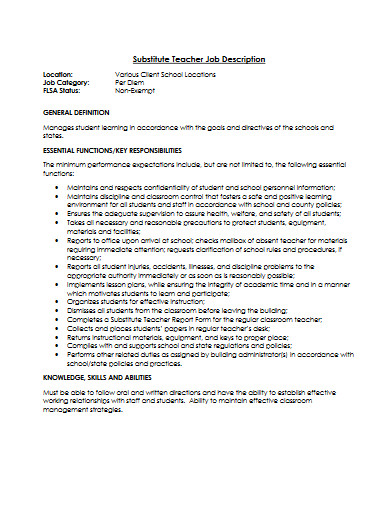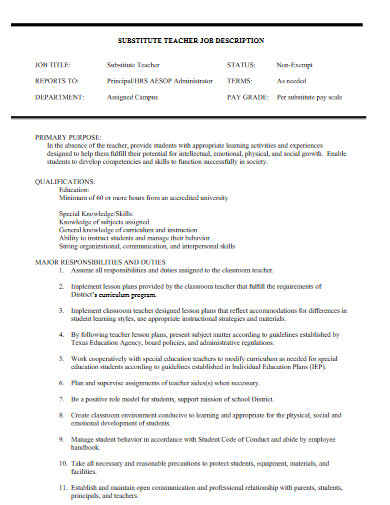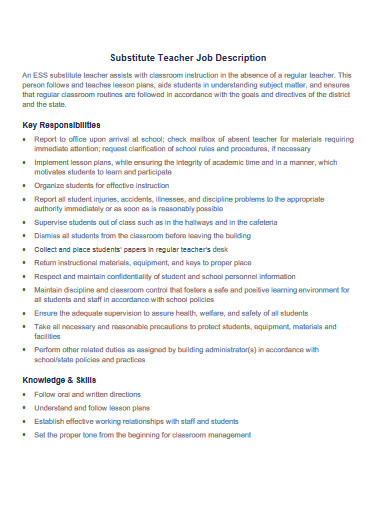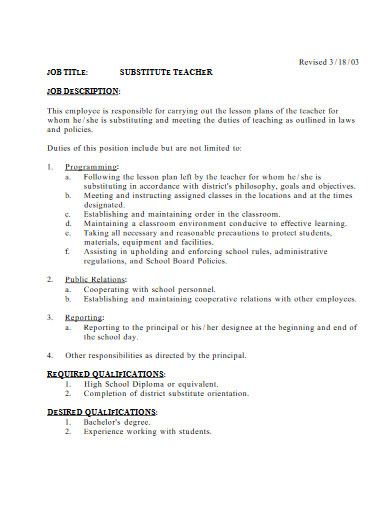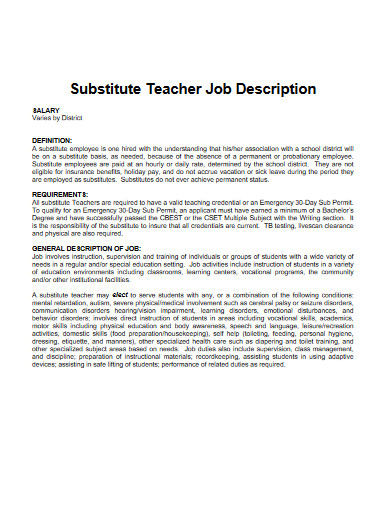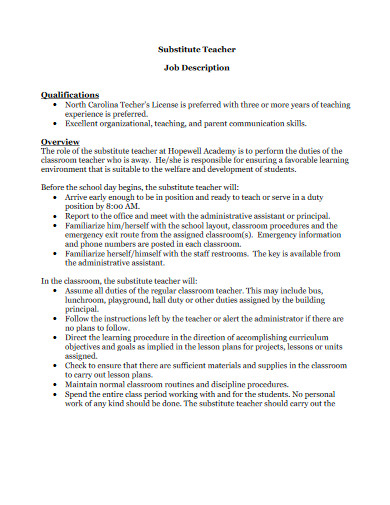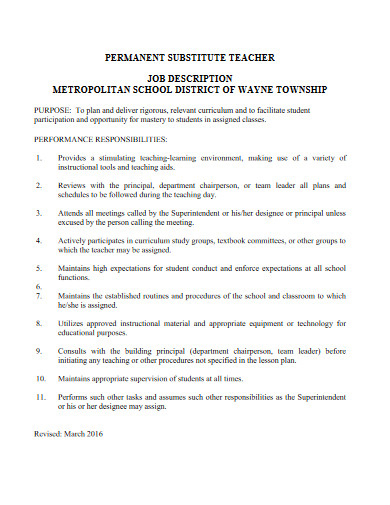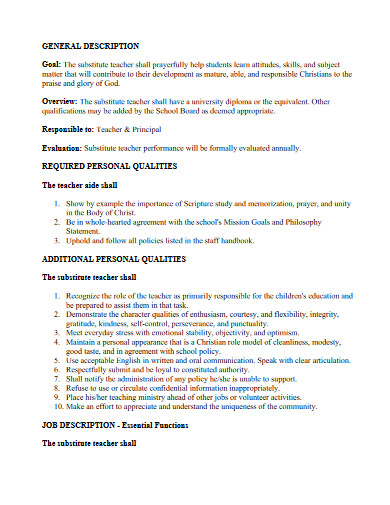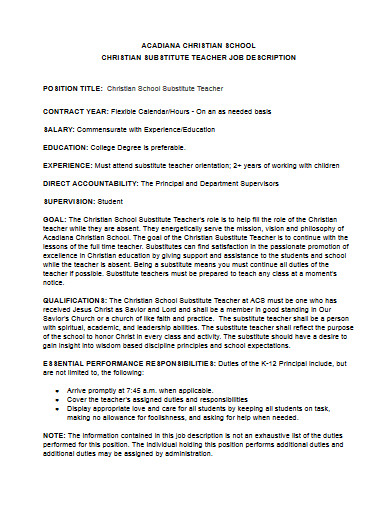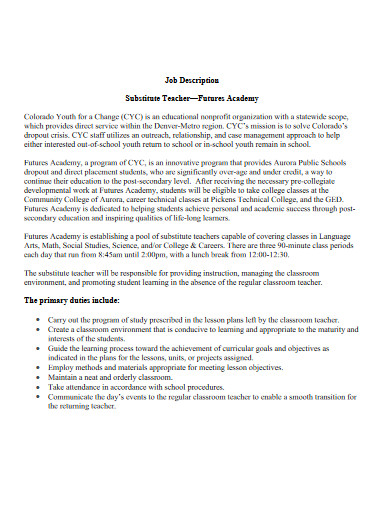10+ Substitute Teacher Job Description Examples to Download
A substitute teacher position requires specific skill sets, educational background, length of experience, and knowledge to qualify for the role. If you’re hiring for the said position, how can you ensure that you’ll lure in the right candidates? Having the right substitute teacher job description on your job announcement is a crucial recruitment matter. This helps the right audience find you, so you’ll be able to include only the best talents in the screening process. This also helps applicants set their expectations and understand what role they’re going to take, allowing them to prepare for it beforehand. Use only the best job descriptions by referring to our collection below.
10+ Substitute Teacher Job Description Examples
1. Substitute Teacher Job Description Template
2. School Substitute Teacher Job Description Template
3. Sample Substitute Teacher Job Description
4. Substitute Teacher Job Description in PDF
5. Substitute School Teacher Job Description
6. Academy Substitute Teacher Job Description
7. Permanent Substitute Teacher Job Description
8. Substitute Teacher Job Description Example
9. General Substitute Teacher Job Description
10. Christian Substitute Teacher Job Description
11. Substitute Academy Teacher Job Description
What Is a Substitute Teacher Job Description?
A substitute teacher job description is a comprehensive list of duties, responsibilities, and qualifications of the said position. It is an important document for the human resource department’s recruiting team as it’s an essential element in inviting interested applicants. A detailed copy of a job description will also include the measuring standards of the role in employee evaluations. It plays a key part in identifying which ones fit the position best during hiring processes and determining which of them failed the criteria in carrying the duties specified in the description.
Parts of a Job Description
According to SHRM, a job description’s purpose does not only limit to identifying the right candidate for the job. It also serves as a useful communication tool in helping employees understand their roles better. Although job descriptions vary in presentation for every company, it contains distinct components to ensure that every necessary detail is included. The following are some of the essential parts of a job description:
1. Job title – job title should be brief and should reasonably represent the role of the position.
2. Job overview – this provides the purpose of the job and gives a summary of what the position is all about.
3. Duties and responsibilities – this essentially provides a detailed list of the functions of the position and what the role entails.
4. Educational background – this provides the educational background to qualify for the position.
5. Experience – this contains the specific number of years in a particular industry that an employee must have to apply for the job.
6. Knowledge and skills – this section gives the list of specific skill sets and the knowledge it takes to perform the job’s duties and responsibilities.
How to Write a Substitute Teacher Job Description
The following are some helpful guidelines that you can use in writing a substitute teacher job description:
1. Use the Right Job Title
You might want to get creative with your job title with cliches such as “Superstar Writer” or “Wonder Office Staff,” but they might shoo away interested applicants. You won’t also want to exaggerate the position title such as the Head Mobile Distributer when you mean Delivery Man or using Sanitation Officer when you mean Janitorial Staff. You might think this makes your job announcement more attractive, but it actually does not.
The term Substitute teacher should be enough to describe the position you’re going for. Your job title should describe the position correctly, so it draws the right audience towards it.
2. Do a Job Analysis
This might not be necessary if you already have a job description in your archives, because all you’ll need to do is to update it according to your workplace’s current setting. However, if you’re new to this and you’re starting your job description form scratch, it’s best to perform a job analysis. This helps you identify the different duties and responsibilities that the position will perform. Out of this, you’ll also be able to identify the various skills and competencies that will qualify for the job.
This way, you’ll generate a fact-based result that the prospective applicants can rely on. This is important because they will most probably base their application materials such as their substitute teacher cover letter and resume from your list of qualifications.
3. Don’t Use Superlatives
Again, exaggerations will not help you sell the position efficiently. Using words such as “the best and brightest,” “world-class,” and “champions” might intimidate job hunters from trying out the position. You’ll be shooing away skilled individuals who refuse to label themselves with these extreme traits.
Your job marketing posters and employment advertising flyers may go unnoticed compared to ads that employ neutral language. Keep your job description direct, professional, and relatable so you’ll be able to draw in as much crowd as possible.
4. Sell Your Company Culture
Most companies might think that people are only interested in how much benefits they’re going to receive. Actually, most applicants often wonder what their life is going to be like if they choose to join a specific organization. The job market contains similar benefits, similar payslip figures, and similar duties and responsibilities for a certain job position. Where do they differ? The company culture, of course.
Showcase your perks and what it’s going to be like working under your wing. If you’re an academy making a subject teacher job description, or a teaching assistant job description, include benefits and highlight facilities that show your institution’s education quality.
FAQs
What should you exclude from your job description?
Here are some things that you should exclude when making your job description:
- Any form of bias and discrimination
- Placing unrealistic requirements
- Ambiguous information
- Negative remarks
How do you differentiate a job specification from a job description?
Job specifications are more detailed than job descriptions. While a job description may provide an overview of a specific position’s duties, a job specification provides details of what an individual must have to qualify for the post. This includes training, personality traits, and skills. Therefore, a job description is attached to the job itself, while a job specification refers to an individual’s qualities.
Does a substitute teacher need a teaching license?
No. A substitute teacher’s most basic requirement is to have a Bachelor’s Degree.
A teaching profession is among the world’s noblest jobs. Taking on multiple classes in multiple subject areas for the entire is a tough calling to fulfill. If you want to ensure that you’ll get the best candidates for a substitute teacher post, have a reliable substitute teacher job description template on your side. Get yours from our professionally-made collection. Download now!



